Inbound Lead Generation: Everything You Need To Know

Back in the past, making unrequested calls and sending bulk emails were praised as signs of great customer service. In today’s rapidly evolving world, customers are no longer happy with these outdated tactics. People are seeking more personalized and informative interactions with brands.
Consequently, selling something in the real world has become a tricky shot. With customers demanding clarity and knowledge before making any serious decisions, businesses face new challenges. And the question arises – how can businesses adapt to this shifting scenario and connect with their audience effectively?
Dive into the concept of inbound lead generation. It’s not just a buzzword; it’s the key to huge opportunities for your business. It’s all about attracting ideal customers naturally, providing them with valuable information, and establishing meaningful connections that persist.
In this article, we will discuss everything inbound; from theory to exploring real-life scenarios, effective strategies, essential tools, and best practices, we’ll cover it all step-by-step.
Let’s start with the basics.
What is lead generation
Simply put, lead generation is like finding new friends for your business. As we always (in most cases) want to make new friends at different stages of our life, businesses also want to find new people who might be interested in what they’re selling. For a business, these newly connected people are called LEADS.
Imagine you have a cool gadget that you want to share with your friends who might like your gadget too. So, to have such friends, what would you do?
You maybe ask your classmates, talk to the same-age neighborhood, approach your cousins, or even you can just show off your gadget. And when someone shows interest and wants to check out your gadget, they become a lead (friend) for you. And same goes for business lead generation.
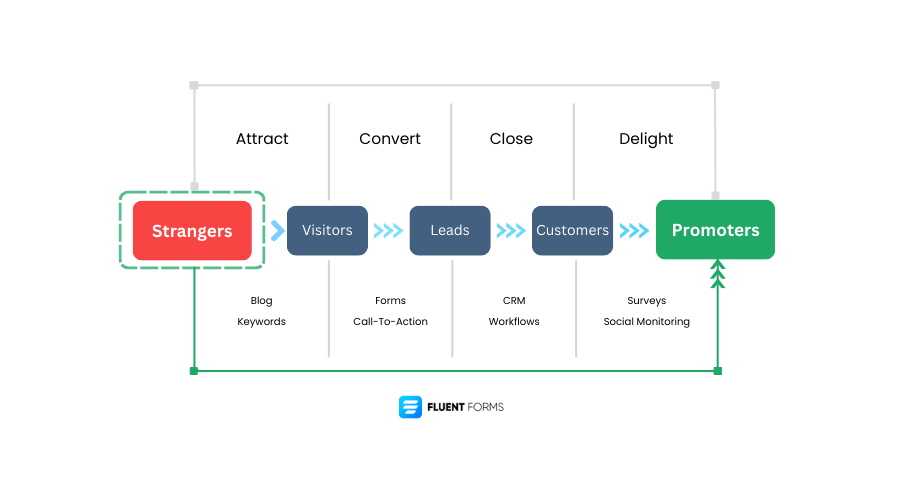
So, lead generation can be defined as the process of attracting new people who might be interested in what your business has to offer, just like you find new friends who might like your gadget.
Importance of lead generation in digital marketing
You already know what lead generation is, but what’s its importance, particularly in Digital Marketing?
Lead generation is critical in digital marketing as it drives sales, facilitates targeted marketing, cultivates customer relationships, provides valuable data, offers cost-effective marketing options, and whatnot.
In Digital Marketing, the lead generation method utilizes ONLINE platforms, strategies & tactics such as ads and email campaigns, social media, websites, and more.
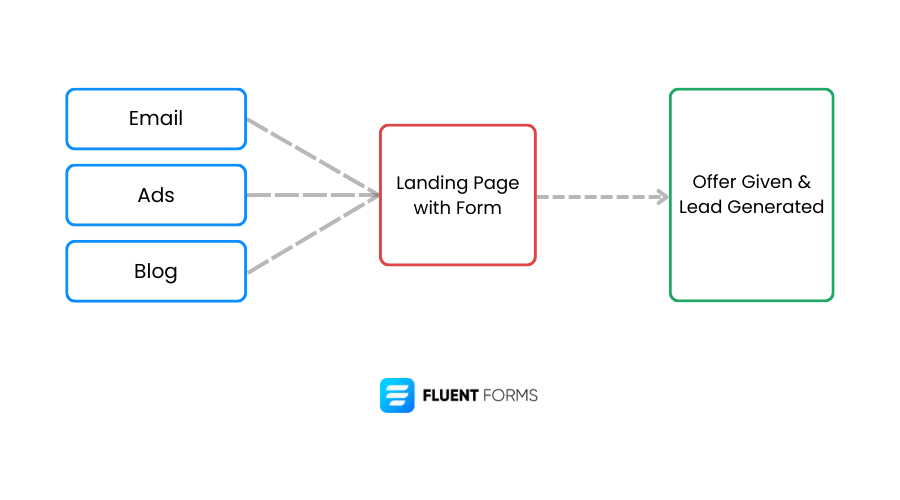
Let’s discuss the benefits of lead generation in digital marketing in the following section.
Benefits of lead generation
While lead generation is the key to business success, this is obvious that there are tons of advantages associated. However, here are the major 6 points that sum up the overall benefits of lead generation.
“Without lead generation your business will be pretty dead in a short period of time”
Marco Cirillo
- Boost sales and revenue: Strategic lead generation attracts and transforms potential customers into paying customers. By inducing a persistent stream of qualified leads, businesses have a higher opportunity to increase sales & revenue.
- Focused marketing: it significantly helps businesses to focus their marketing efforts on a specific audience. This precise targeting leads to more efficient marketing campaigns and higher conversions.
- Cultivating customer relationships: Lead generation is not just a process of one-time sales. By nurturing leads through personalized communication, businesses can build trust, credibility, and loyalty which leads to repeat sales and referrals.
- Data collection and insights: Lead generation generates valuable data and insights about potential customers that can be used to refine marketing efforts.
- Cost-effective marketing: Lead generation in digital marketing can be more cost-effective than traditional marketing.
- Scalability and growth: A successful lead generation strategy provides a scalable foundation for business growth.
Types of lead generation
There are two types of lead generation in business; Outbound & Inbound Lead Generation. Let’s have a quick discussion.
1. Inbound lead generation: Inbound lead generation mainly focuses on attracting prospective customers who are seeking information or solutions relevant to your business’s products or services. Some common inbound tactics include:
- Content marketing
- Search engine optimization
- Social media marketing
- Lead capture forms
- Webinars and events
2. Outbound lead generation: Outbound lead generation implicates businesses proactively reaching out to prospective customers to start conversations and generate leads. Some typical outbound lead generation tactics include:
- Cold calling
- Email Marketing
- Paid advertising
- Trade shows
- Direct mail
Both inbound and outbound lead generation methods have their benefits and can be effective when utilized properly. But today our catch is about inbound lead generation.
Let’s crack into it.
Inbound lead generation: Understanding the concept
Imagine you have a T-shirt store, and you want to sell your cool T-shirts to people who really want them. Inbound lead generation is like setting up your t-shirt store in a popular place where fashion enthusiasts naturally visit.
Instead of trying to convince people to buy your t-shirts, you create a sign that says things like “100% Cotton T’s! Enjoy Summer in Style” and set them in front of your store. The sign grabs the attention of people passing by who are already looking for some cool t-shirts for summer.
When people see your signs and get interested, they come up to your store and ask about different products. And here’s the catch, these people are your inbound leads because they reached your store on their own just following the sign you set.
In the exact same way, businesses practice inbound lead generation in digital marketing. They create engaging websites, share valuable content, and optimize their online presence so people can find them easily when they’re searching for information/solutions related to their brand.
In the following sections, we’ll discuss some essential terms/concepts you would encounter in the process.
What is an inbound lead
You can already sense it. Ideally, an inbound lead is a prospective customer who has shown interest in a company’s products/services and has taken some sort of action to engage with the business.
These actions are typically started by the lead themselves, without a direct approach from the business.
In terms of digital marketing, an inbound lead is someone who finds your business through various online channels like search engines, social media, or content marketing and responds to a piece of content that is part of your inbound lead generation strategy. For instance, a response could be:
- Downloading an Ebook
- Filling out a contact form
- Subscribing to a newsletter, etc.
Inbound lead qualification
There are 3 types of leads based on how they are qualified and what stage they’re in your strategic funnel.
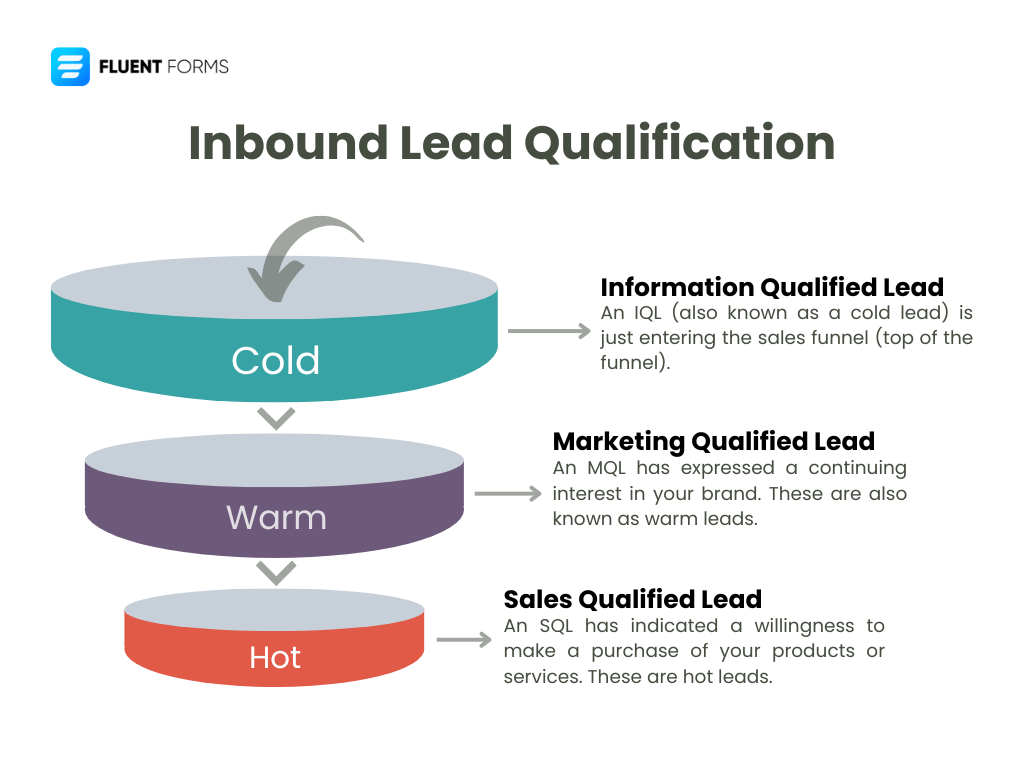
- Information qualified lead (IQL)
An information-qualified lead (also known as a cold lead) is just entering the sales funnel (top of the funnel). An IQL is a potential customer just entering the buyer’s journey. Such leads look for information about your business to see if it can help them solve their problems.
- Marketing qualified lead (MQL)
A marketing-qualified lead has expressed a continuing interest in your brand. These warm leads seek ways to use your products to solve their problems.
- Sales qualified lead (SQL)
A sales-qualified lead has indicated a willingness to make a purchase of your products or services. Such leads are the hot leads that your sales force is ready to convert into committed customers.
Now is the time to learn about some effective inbound lead generation strategies that you can utilize for your business.
4 Effective inbound lead generation strategy
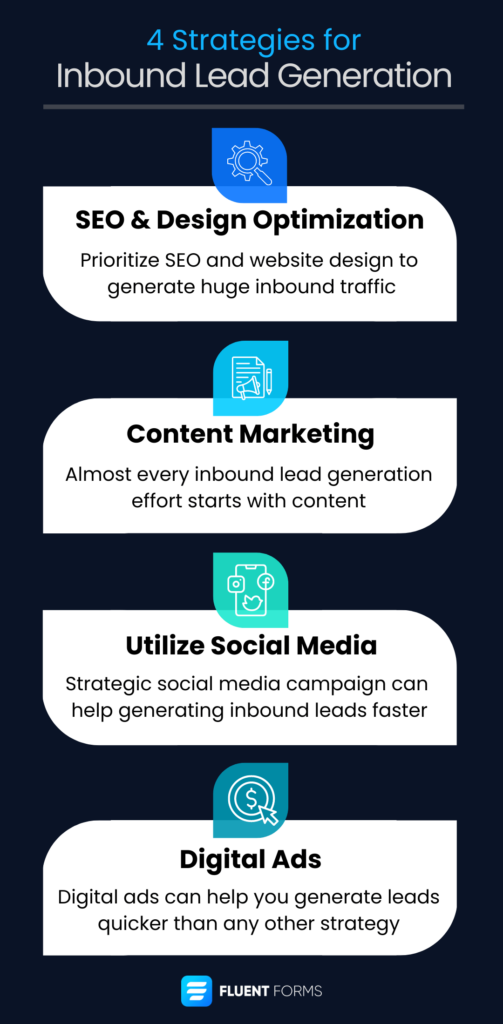
Inbound lead generation is about pulling prospective customers in rather than pushing your message when they don’t want to see it. That’s why inbound lead generation needs strategic approaches.
You can attract your prospective customers in different ways. Here are 4 prominent inbound strategies you must follow:
1. SEO and design optimization
In this era, people are using the internet to instantly find information online. They tend to use search engines like Google for solutions to any problem. This is why your website’s search engines’ compatibility and design are so crucial for inbound lead generation.
We all know most people these days start searching for information in the same place: a search engine. There are lots of search engine options available like Google, Bing, Yahoo, etc.
And your brand website is where you display all of your content that might help your potential customers and lead to conversation.
So, if you don’t optimize your website for the search engines, your potential customers will not find you and your website will just go in vain. And same goes for the design of your website; if the design doesn’t resonate with your ideal customers, they will immediately bounce from your website.
In this regard, prioritize SEO and the design of your website to generate a great amount of inbound traffic for your business. And needless to say, this is the basic and most effective inbound lead generation strategy you should follow.
2. Content marketing
In the Digital Marketing industry, there’s only one king; The Content! Almost every inbound lead generation effort starts with content, certainly, valuable content!
Content could be blog posts, ebooks, videos, images, etc. And these are the driving force behind a great lead generation campaign.
By creating valuable content, you can attract prospective customers for your brand, and if your audience finds your content truly helpful they will stay engaged and eventually convert to what you desire.
To initiate your content marketing efforts for generating leads, you need to be careful about your business niche, your ideal audience, and the persona of your customers so that you can create content that resonates with their pain points.
For example, you’re selling T-shirts online, and you’re providing content related to the fashion industry. You create content like “5 Best Summer Outfits, 3 Best Fabrics for Summer Outfits, etc”.
Writing on these topics will capture your web visitors’ attention, and they will likely engage with your content and click on your strategic CTAs.
Keep in mind that, the more your visitors are delighted with your content, the more likely they are to convert as an ideal lead for your business.
3. Social media platforms
With more than 5 billion active monthly users, you don’t dare overlook the potential of Social media platforms. This has the potential to become your one-stop solution for generating inbound leads.
By planning a strategic social media marketing campaign, you can gain huge inbound leads in no time.
To generate ideal leads on social media, you need to provide value to your audience as we also discussed for content marketing. If your audience finds your content insightful, then they will convert naturally. And that’s the power of social platforms.
There are so many social platforms you can utilize for your brand and generate leads. Considerably the most popular platforms are Facebook, Instagram, Twitter, Reddit, LinkedIn, Tumblr, TikTok, and many more.
4. Digital ads
So far the strategies we’ve discussed are actually organic & time-consuming methods. To boost your inbound lead generation efforts you can utilize paid media ads. It can help you generate leads faster than any other strategy.
Another plus point is retargeting. Suppose, you got thousands of website visitors, but only a few click your links or engage with your content. In this case, don’t just think that the maximum number of people don’t like your brand or content. Some maybe got distracted for lots of reasons and left your website.
With the help of digital ads, you can retarget those visitors who showed interest in your brand but didn’t engage for some reason. By targeting them you can easily convert them into your potential leads.
So, you should track the visitors’ movement on your website and show your ads to remind them again about your business.
Now you know some of the most effective inbound lead generation strategies. Let’s discuss some essential tools you need to execute your lead generation efforts.
3 essential tools for inbound lead generation
Here are 3 essential tools that make the complex task of inbound lead generation a lot easier.
1. Fluent Forms
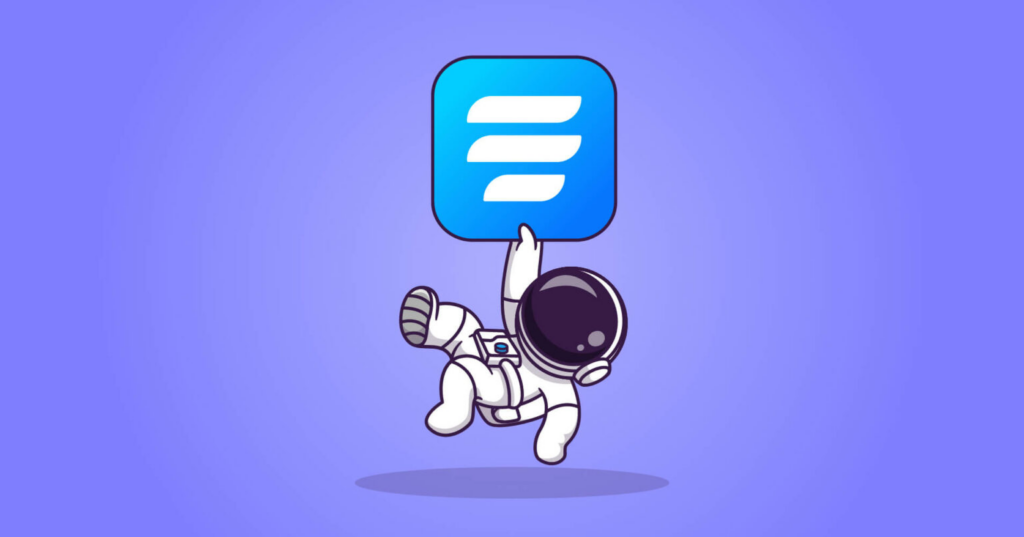
Fluent Forms is a powerful WordPress form builder tool designed for effortless inbound lead generation and to enhance overall user experiences.
Thousands of businesses worldwide use Fluent Forms for its smooth user experience, customization, flexibility, and numerous efficient features. Not only for lead generation, but it also has a lot of different other uses.
Let’s check some of the core features of Fluent Forms.
- Super-easy drag-and-drop builder
- Advanced conditional logic
- Conversational form
- Multi-Step forms for better engagement
- 50+ Integrations
- Smart Spams Protection
- Easy payment methods
- Quiz module
- Dedicated landing page
- Calculated fields, and more.
So, how Fluent Forms can help you in inbound lead generation? Let’s see some of the use cases:
- Lead capture form: having a lead capturing tool is a must for any lead generation campaign, and Fluent Forms can do the job for you. With Fluent Forms’ lead capture function, you can collect essential information about your Leads seamlessly.
- Newsletter sign-up form: these sign-up forms can also be used to capture contact information from website visitors.
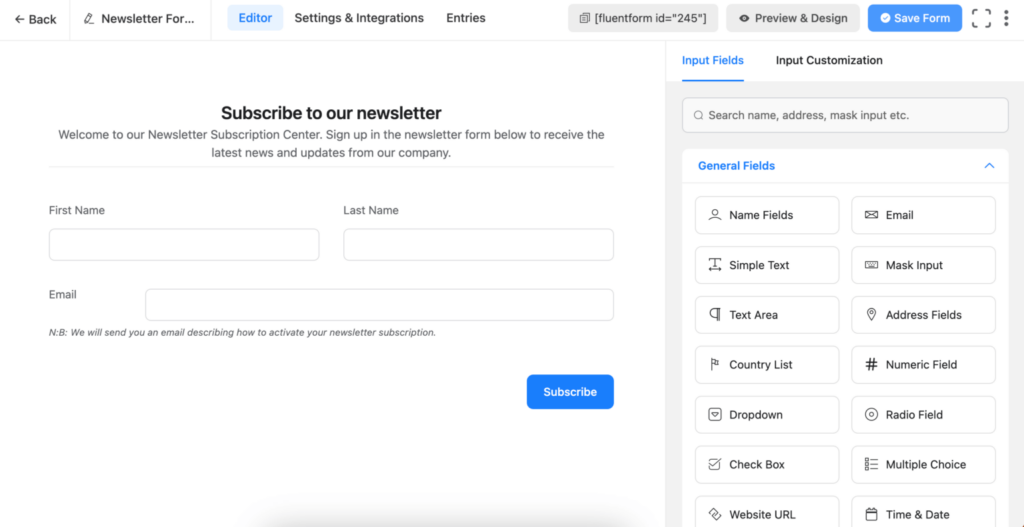
- Event registration form: If you plan for an event and want new users to join in, then these registration forms can help you collect the necessary information.
- Contact Forms: Contact forms can serve as a way for potential leads to reach out to your business with inquiries or questions.
- Survey forms: Surveys can provide valuable insights into potential customers’ preferences and needs.
- Application Forms: This form can help as a lead generation tool for businesses offering services or memberships.
So, using Fluent Forms you can execute your inbound lead generation campaign efficiently.
2. Fluent CRM
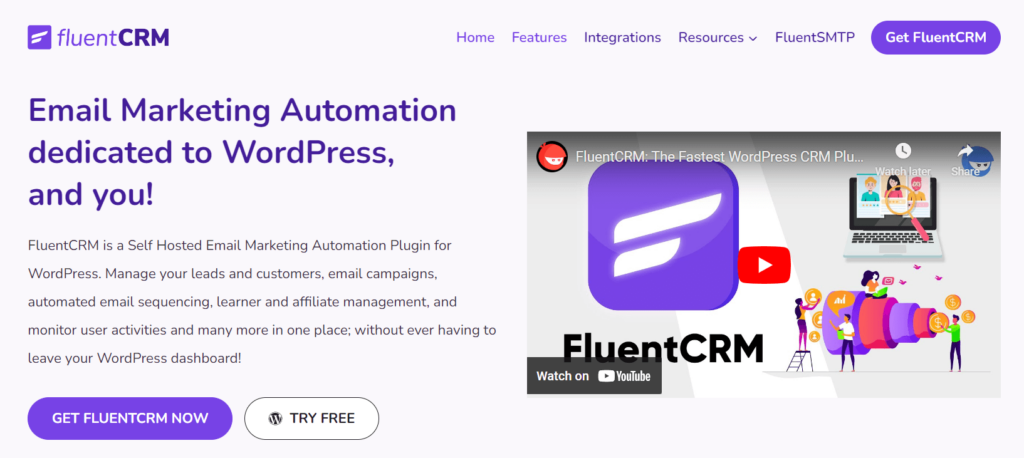
FluentCRM is the fastest and most effortless email marketing, newsletter, and CRM solution plugin. With this plugin, you can build your email lists, segment, manage customer relationships, create funnels and run email campaigns.
In your effort to inbound lead generation, this tool will extensively help you in collecting leads, automating emails, displaying subscription forms, nurturing the leads, and whatnot. Let’s check what it offers.
- Schedule email campaigns
- Campaign reports
- Marketing automation
- Track campaign performance
- Add images
- Integrated opt-in forms
- Built-in analytics
Here’s more, you can see your full business insight by using charts, graphs, and widgets from your FluentCRM dashboard.
3. Brave
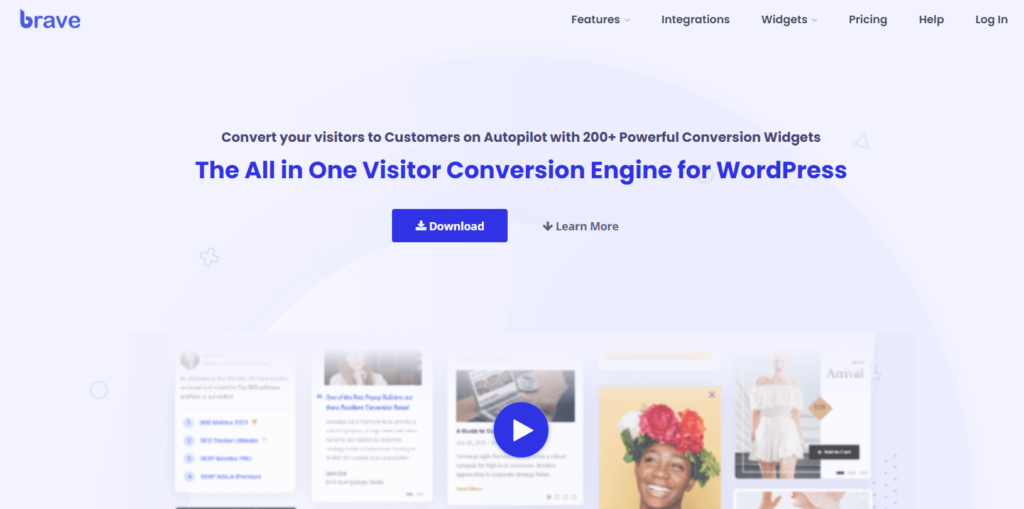
Brave is a popular built-in widget builder in WordPress. It’s known for making sidebars, pop-ups, lead-generating, sticky bars, and converting your visitors into prospective clients. Some intuitive functions are:
- Drag and drop builder
- Conversion widget
- Visual editor
- Advanced forms
- Custom coding option
- Easy Targeting
- Built-in analytics
Another worth mentioning is its Woocommerce integration that increases your store’s up-sell, cross-sell, or related products popup.
So, you have the strategy and necessary tools to generate leads. Now we’re going to discuss some of the lead generation best practices that will help you generate inbound leads more efficiently.
Lead generation best practices
Whether it is outbound or inbound lead generation, there are some universal best practices for better results. Let’s take a look:
- Define target audience persona: You should clearly define your target audience first & personas to create content that resonates with their needs and pain points.
- Create great content: Create insightful and relevant content that delivers value to your audience, establishing your brand as a resource hub.
- User-centric website: Make sure your website is user-friendly, easy to navigate, and responsive for both desktop and mobile devices.
- Clever & clear CTAs: Use persuasive calls-to-action on your website and landing pages to drive your visitors towards the desired actions.
- Set lead magnets: Offer helpful lead magnets like ebooks, guides, or free tools, to attract & convince visitors to provide their contact details.
- Optimized landing pages: Build dedicated landing pages for every offer, product, or service with a focus on conversion.
- Proper email marketing segmentation: Label your email lists based on users’ behavior and choices, sending personalized content to different audience segments.
- Ensure social media engagement: Engage with your audience on social platforms, cordially respond to comments and messages, and share helpful content.
- Live support: Consider implementing live chat support on your website to provide real-time assistance to visitors and capture leads.
- Lead scoring & nurturing: Utilize lead scoring to prioritize leads and run lead nurturing campaigns to drive them through your sales funnel.
- Show customer testimonials: Collect & show customer testimonials and case studies on your website to build trust and credibility.
- Data privacy & security: Make sure that you comply with data privacy regulations and gain consent for marketing purposes.
- A/B testing: Continuously experiment with different elements of your lead generation strategy to optimize conversion rates.
- Analytics and metrics: Track and analyze key metrics to measure the performance of your strategies and make data-driven decisions.
- Continuous improvement: Review and update your inbound lead generation efforts to stay relevant and effective all the way.
By following these lead generation best practices, you can set a solid foundation for your inbound lead generation efforts, attract quality leads, and nurture them into happy customers.
Enjoying this article?
We regularly publish actionable content on our blog. Subscribe to get them delivered straight to your inbox.
We won’t spam you. You can unsubscribe whenever you want.
Wrapping up
Inbound lead generation is a powerful way of attracting ideal customers naturally and building meaningful relationships. By creating valuable content, optimizing your website, utilizing social media, and using the right tools like Fluent Forms, Fluent CRM, and Brave, you can gain quality leads for your brand.
Don’t miss out on following the best practices, like defining your target audience, offering lead magnets, and continuously improving your overall efforts. Utilize the power of inbound lead generation strategically, and watch your business grow with active and happy clients.

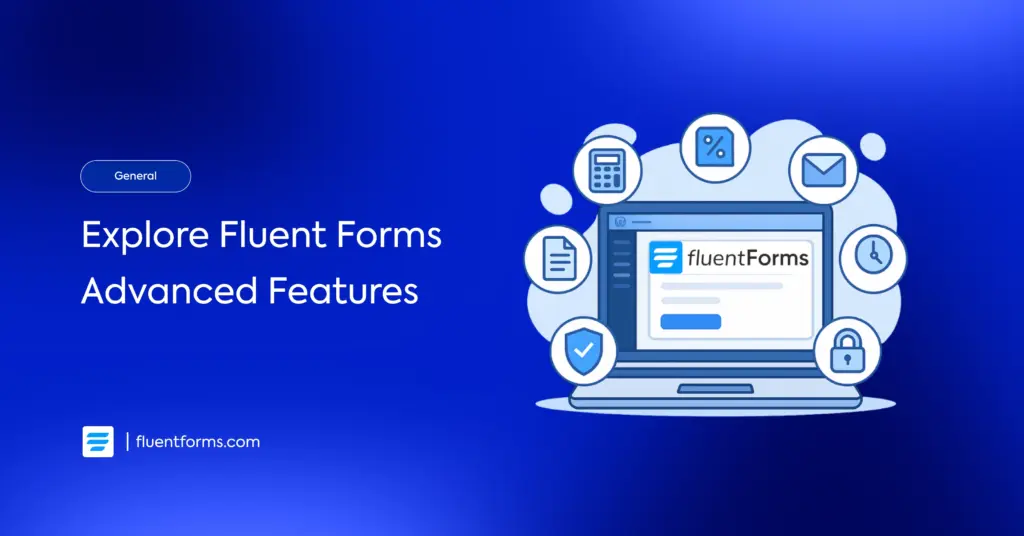
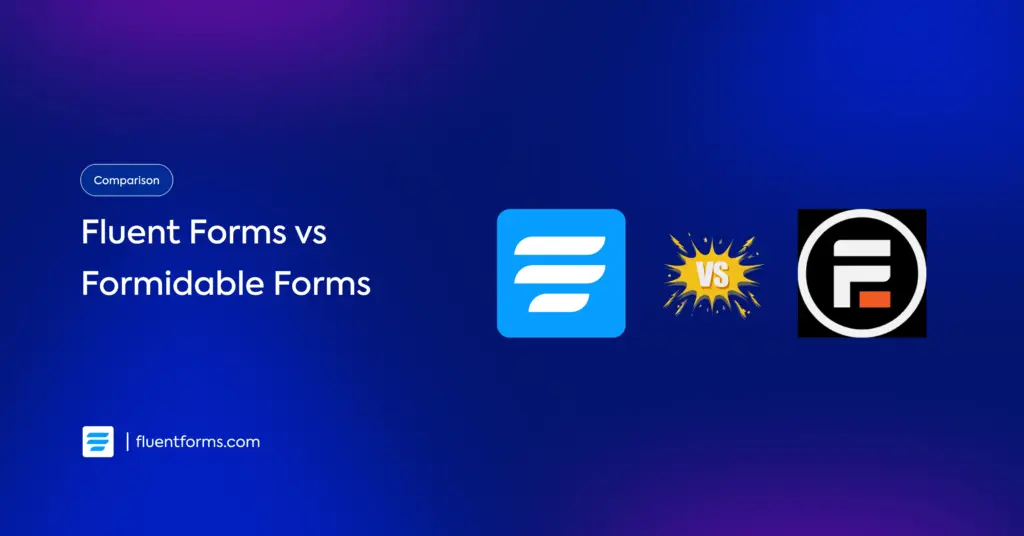




Leave a Reply